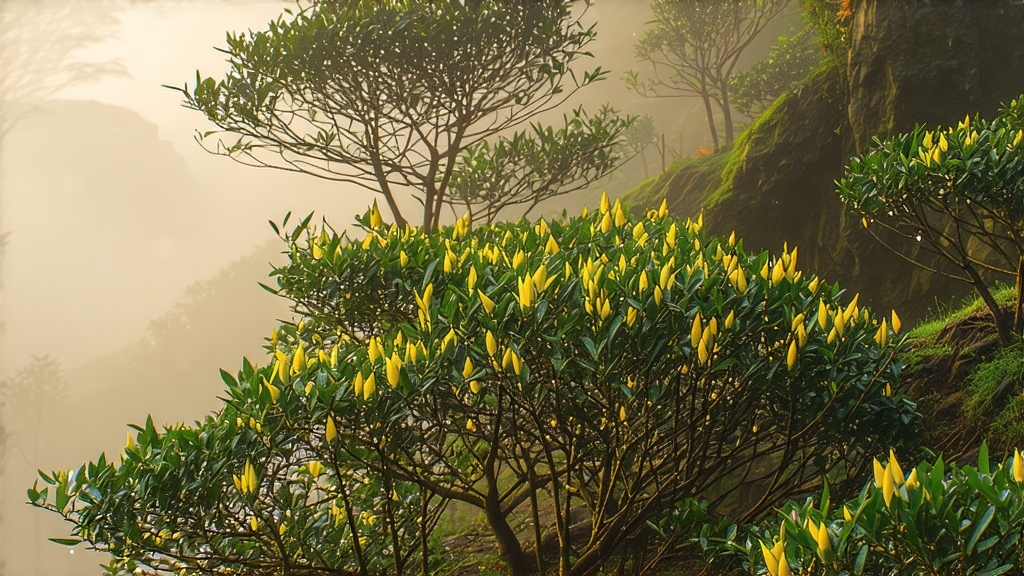
High on the shoulders of Mount Meng, where Sichuan’s clouds brush the backs of wild pandas, a tea once reserved for emperors still unfurls its single, downy bud each spring. Meng Ding Huang Ya—literally “Yellow Bud from Meng Summit”—is the least-known yet most aristocratic member of China’s yellow-tea family. While green tea races to lock in freshness and dark tea revels in decades of post-fermentation, yellow tea pauses: it breathes, it waits, it “seals” its own fragrance in a micro-fermentation step so elusive that even veteran tea makers call it “the craft of half a breath.” To understand this leaf is to witness time being stretched like silk, then tucked inside a tiny golden curl.
Historical whispers
The first written record appears in a Tang-dynasty stele dated 816 CE, carved by a monk who thanked the mountain for “a liquor the color of goose fat, calming the five agitations.” By the Song, the buds were pressed into silver molds and sent down the Min River as tribute; the imperial court decreed that only leaves picked before the Qingming festival could bear the Meng Ding name. When Ming tea masters abandoned compression cakes in favor of loose leaf, the yellowing technique—unique wrapping in thick paper after fixation—was invented here to prevent the grassy edge that so often accompanied early-harvest greens. Thus an accident of preservation became an art of elevation, and Meng Ding Huang Ya entered the Qing emperor’s “Top Ten Teas” scroll of 1727. Revolution, war and market neglect later pushed it to the brink of extinction; fewer than 200 kg were produced annually during the 1980s. Today, protected by a geographical indication since 2007, the tea survives through a core of thirteen family workshops whose average age exceeds sixty-five. Their sons and daughters, armed with ecology degrees and Instagram accounts, are coaxing the yellow bud back onto the world stage.
Micro-terroir on the roof of Sichuan
Mount Meng rises 1,456 m above the Chengdu plain, trapping humid air from the Tibetan Plateau. The result is a 78 % average relative humidity and a temperature amplitude of 12 °C between day and night—ideal for slow amino-acid accumulation. Soils are Devonian sandstone leached by constant mist, yielding a sandy loam so porous that tea roots can descend two meters in search of mineral water. The indigenous cultivar, “Meng Ding Qun Ti Zhong,” is a mixed population of sinensis and assamica traits that has cross-pollinated for over a millennium, giving small, thick leaves capable of withstanding the repeated heat shocks of yellowing. Because the mountain sits inside a UNESCO panda corridor, pesticides are banned; instead, farmers plant aromatic citronella grass every seventh row to confuse leafhoppers.
The craft of “men huang”—sealed yellowing
Picking begins when the dawn mist still carries night frost. Two leaves and a bud are snapped sideways, never upward, to keep the tiny stem hollow and allow later moisture migration. The first wok, at 160 °C, is a 4-minute sha qing (kill-green) that destroys leaf enzymes yet keeps oxidase edges alive—an essential contradiction. While still at 50 °C, the leaves are piled 3 cm thick on bamboo trays, covered with steamed cotton cloth, then slid into a pine-wood cabinet. For the next 48 hours the tea maker performs “fan huang”—turning every 90 minutes to homogenize heat and CO₂. During this pause, non-enzymatic browning generates theaflavins and benzaldehyde, gifting the nut-sweet aroma that connoisseurs liken to roasted soybean milk. A second, lower wok at 80 °C sets the yellow color, followed by three days of charcoal baking at 45 °C. The entire process consumes 26,000 buds to yield one kilogram of finished tea, each bud having lost 82 % of its weight.
Grades and morphology
Imperial Grade (Tribute Tip): 100 % single buds, 8–12 mm long, downy, lemon-yellow with a faint jade vein visible when back-lit.
First Grade: one bud and one unfolded leaf, resembling a sparrow’s tongue, liquor bright melon-yellow.
Second Grade: one bud and two leaves, still aromatic but lacking the sustained sweetness of the tip grade.
A curious defect called “